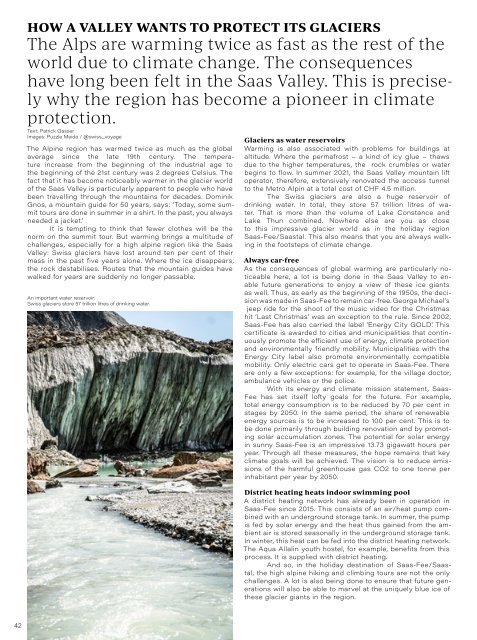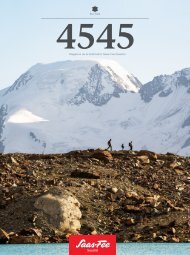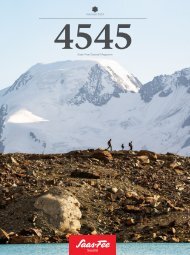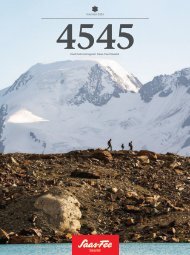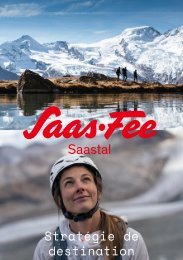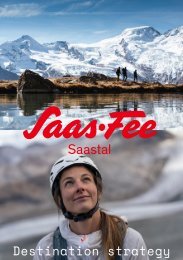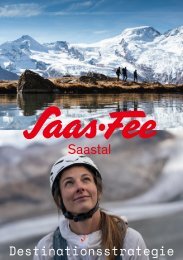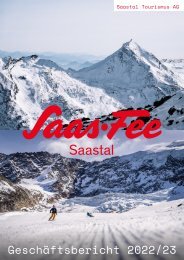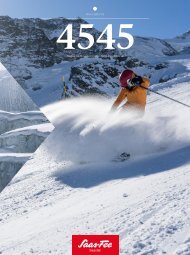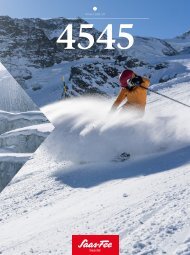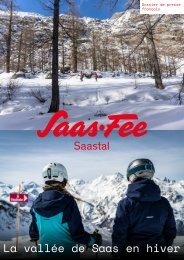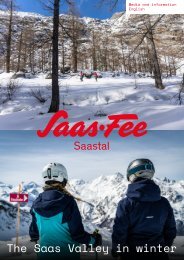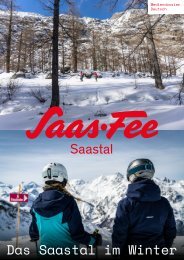Create successful ePaper yourself
Turn your PDF publications into a flip-book with our unique Google optimized e-Paper software.
HOW A VALLEY WANTS TO PROTECT ITS GLACIERS<br />
The Alps are warming twice as fast as the rest of the<br />
world due to climate change. The consequences<br />
have long been felt in the Saas Valley. This is precisely<br />
why the region has become a pioneer in climate<br />
protection.<br />
Text: Patrick Gasser<br />
Images: Puzzle Meida / @swiss_voyage<br />
The Alpine region has warmed twice as much as the global<br />
average since the late 19th century. The temperature<br />
increase from the beginning of the industrial age to<br />
the beginning of the 21st century was 2 degrees Celsius. The<br />
fact that it has become noticeably warmer in the glacier world<br />
of the Saas Valley is particularly apparent to people who have<br />
been travelling through the mountains for decades. Dominik<br />
Gnos, a mountain guide for 50 years, says: ‘Today, some summit<br />
tours are done in <strong>summer</strong> in a shirt. In the past, you always<br />
needed a jacket.’<br />
It is tempting to think that fewer clothes will be the<br />
norm on the summit tour. But warming brings a multitude of<br />
challenges, especially for a high alpine region like the Saas<br />
Valley: Swiss glaciers have lost around ten per cent of their<br />
mass in the past five years alone. Where the ice disappears,<br />
the rock destabilises. Routes that the mountain guides have<br />
walked for years are suddenly no longer passable.<br />
An important water reservoir:<br />
Swiss glaciers store 57 trillion litres of drinking water.<br />
Glaciers as water reservoirs<br />
Warming is also associated with problems for buildings at<br />
altitude. Where the permafrost – a kind of icy glue – thaws<br />
due to the higher temperatures, the rock crumbles or water<br />
begins to flow. In <strong>summer</strong> 2021, the Saas Valley mountain lift<br />
operator, therefore, extensively renovated the access tunnel<br />
to the Metro Alpin at a total cost of CHF 4.5 million.<br />
The Swiss glaciers are also a huge reservoir of<br />
drinking water. In total, they store 57 trillion litres of water.<br />
That is more than the volume of Lake Constance and<br />
Lake Thun combined. Nowhere else are you as close<br />
to this impressive glacier world as in the holiday region<br />
Saas-Fee/Saastal. This also means that you are always walking<br />
in the footsteps of climate change.<br />
Always car-free<br />
As the consequences of global warming are particularly noticeable<br />
here, a lot is being done in the Saas Valley to enable<br />
future generations to enjoy a view of these ice giants<br />
as well. Thus, as early as the beginning of the 1950s, the decision<br />
was made in Saas-Fee to remain car-free. George Michael’s<br />
jeep ride for the shoot of the music video for the Christmas<br />
hit ‘Last Christmas’ was an exception to the rule. Since 2002,<br />
Saas-Fee has also carried the label ‘Energy City GOLD’. This<br />
certificate is awarded to cities and municipalities that continuously<br />
promote the efficient use of energy, climate protection<br />
and environmentally friendly mobility. Municipalities with the<br />
Energy City label also promote environmentally compatible<br />
mobility. Only electric cars get to operate in Saas-Fee. There<br />
are only a few exceptions: for example, for the village doctor,<br />
ambulance vehicles or the police.<br />
With its energy and climate mission statement, Saas-<br />
Fee has set itself lofty goals for the future. For example,<br />
total energy consumption is to be reduced by 70 per cent in<br />
stages by 2050. In the same period, the share of renewable<br />
energy sources is to be increased to 100 per cent. This is to<br />
be done primarily through building renovation and by promoting<br />
solar accumulation zones. The potential for solar energy<br />
in sunny Saas-Fee is an impressive 13.73 gigawatt hours per<br />
year. Through all these measures, the hope remains that key<br />
climate goals will be achieved. The vision is to reduce emissions<br />
of the harmful greenhouse gas CO2 to one tonne per<br />
inhabitant per year by 2050.<br />
District heating heats indoor swimming pool<br />
A district heating network has already been in operation in<br />
Saas-Fee since 2015. This consists of an air/heat pump combined<br />
with an underground storage tank. In <strong>summer</strong>, the pump<br />
is fed by solar energy and the heat thus gained from the ambient<br />
air is stored seasonally in the underground storage tank.<br />
In winter, this heat can be fed into the district heating network.<br />
The Aqua Allalin youth hostel, for example, benefits from this<br />
process. It is supplied with district heating.<br />
And so, in the holiday destination of Saas-Fee/Saastal,<br />
the high alpine hiking and climbing tours are not the only<br />
challenges. A lot is also being done to ensure that future generations<br />
will also be able to marvel at the uniquely blue ice of<br />
these glacier giants in the region.<br />
The Alps are warming twice as much as the global average.<br />
There are many other<br />
sustainable projects going on in the Saas Valley.<br />
saas-fee.ch/nachhaltigkeit<br />
42 43


